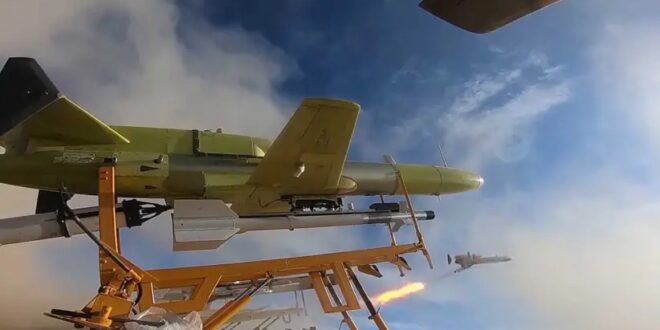Iran has pioneered drones by copying US drones, such as the Predator or Sentinel. It has also copied other drone models it has seen around the world.
An incident on Tuesday in which an unmanned aerial vehicle was shot down in the North after it approached the border represents a growing drone threat to Israel. The IDF shot down the Iranian UAV with an Apache helicopter near Beit She’an.
An Iranian drone carrying explosives and flown from Syria’s T-4 base in February 2018 also penetrated the same area.
Israel has had to contend with growing drone threats during this war in Gaza as well. By Monday, at least six drones had been shot down. Israel used Iron Dome for the first time in combat to take down at least one of the drones. An F-16 shot down another.
The drone threat is increasing, and it is modeled on Iran’s drone army, which the Islamic Republic has pioneered over recent decades.
Tehran has several lines of military drones, some of which are used for surveillance. But many of them are armed.
Iran’s drone strategy is to use them like cruise missiles. You pack them with explosives, put a gyroscope and guidance on them, and then they fly to a preplanned target. They slam into the target and blow up.
This is not unlike the German V-1 rocket of World War II, but it is a bit more complex.
Iran has pioneered them by copying US drones, such as the Predator or Sentinel. It has also copied other drone models it has seen around the world. In addition, it developed some of its own unique models.
The Ababil drone line, for instance, has been exported to the Houthis in Yemen as the Qasef. This drone is launched from a rail or catapult and flies several hundred kilometers to carry out an attack. Hamas has showcased its Shehab drones, which are similar to the Ababil and Qasef, during the recent war.
ISRAEL HAS had to contend not only with UAVs flown by Hamas but also drones that have been spotted on the Lebanese border in recent years and others that flew into Israeli airspace from Syria.
In July 2018, there were two incidents involving drones flying toward Israel from Syria. The IDF used a Patriot missile to shoot at them. One of them penetrated Israeli airspace for a few kilometers before being shot down by the Patriot.
In these cases, Israel says it monitors the drones before shooting them down. For instance, the May 18 incident included the following IDF explanation: “Earlier this morning, a UAV approaching the Israeli border in the Emek HaMa’ayanot area was intercepted after being monitored by the Israel Air Force. The UAV fragments were collected by security forces.”
While not all details are known about the increasing drone threat, it is clear that the last three years have seen an uptick in drone activity on Israel’s Syria, Lebanon and Gaza borders.
Israel is not alone in dealing with the threat: Saudi Arabia has been confronting the Iranian-backed Houthi drones.
Iran attacked Saudi Arabia in September 2019 using drones and cruise missiles. Pro-Iran forces in Iraq have used drones against US facilities there, including carrying out at least two drone attacks this year. Tehran is behind all of this in Yemen, Iraq and Gaza, as well as Syria and Lebanon. Iran is a kind of drone octopus exporting its drones around the region.
IRAN’S DRONES bring something to the battlefield that was not there before. Prior to the Iran drone threat, the main problem was terrorist groups such as ISIS repurposing quadcopters they bought via civilian channels.
For instance, US Central Command Commander Gen. Kenneth McKenzie has warned for a year that drones acquired off the shelf at big-box stores such as Costco are a major threat. He is referring to these small quadcopters, like the DJI line.
These drones can also be built with kits that are not much more sophisticated than Lego tech. Once constructed, they can be programmed and can carry payloads, such as a grenade. ISIS used things like this in the battle for Mosul in 2017. These kinds of drones can be jammed and have a short range.
The Iranian drone threat is much larger and includes drones the size of a person up to the size of a small plane. Often called malat or cli tais in Hebrew, they are essentially large, remote-controlled aircraft. However, because they fly a preprogrammed path to their target, they cannot necessarily be jammed.
That means they are more like a cruise missile. Sometimes they are referred to as “suicide” or “kamikaze” drones. Some are also called “loitering munitions” because they can “loiter” over a target before flying into it.
But Iran’s drones don’t really loiter; they just fly into things. Israel, a pioneer of its own lines of loitering munitions, is an expert in defending against drones with a plethora of anti-drone systems.
These now include Iron Dome, Drone Dome, Re-Drone, Drone Guard, Xtend’s series of net-shooting drones used by special forces, Skylock and other systems. As the threat grows, so does the solution.
 Eurasia Press & News
Eurasia Press & News


